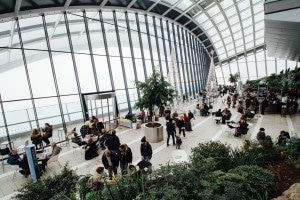The Green Office Trend Is Transforming The Economy

When Wiliam Blake described the “dark, Satanic mills” of the industrial revolution, he articulated what nineteenth-century people thought: industrialization was at odds with nature.
In the early days, the effects of trade and commerce on the environment were relatively limited. Factories were still incredibly rare. And the average country didn’t have the scientific apparatus to collect data on the environment. Nobody knew if burning coal in factories was poisoning the lungs of children.
Today, though, things are different, and we fundamentally appreciate that modern economies take a toll on the environment. The goal now is to create some kind of win-win situation – one in which we keep our current lifestyle, and enable the planet to survive the next million years.
Businesses have a role to play in this process. Not only do they need to make sustainable products, but they also need to ensure that their working practices are green. Many companies, therefore, are investing in green premises – campuses that will confirm them as eco-conscious brands.
The supporting industry behind this trend is now considerable. Thousands of architects and design firms are churning out reprographics that minimizes water and carbon usage while providing amenities for green modes of travel, like bicycle storage. Firms are also looking to provide full bathroom facilities on site so that people can freshen up after journeying to work under their own steam.
The trend for green business premises, however, isn’t just changing the workplace but also transforming the economy as a whole. Companies across sectors now realize that if they want to impress consumers and clients about their green credentials, they have to walk the walk. They can no longer justify cramming people into high-rise offices that guzzle the Earth’s resources. They need something fundamentally more sustainable .
Already we see firms experimenting with all kinds of solutions. Vertical gardens, for instance, adorn the cladding of many buildings. Companies are also installing solar on their roofs and special glass to help with insulation and heating.
Innovations, however, are arriving all the time. Architects, for instance, now understand the importance of creating “energy-positive” buildings that produce more energy than they consume, providing the necessary slack for going carbon neutral.
Companies are also investigating the concept of creating “living walls” in their office complexes. Building surfaces could become replete with plants and shrubs , creating a kind of urban rainforest effect. Planners believe the overall impact will be positive because it will help to scrub the air of pollution while also assisting pedestrians in feeling relaxed.
Another innovation concerns that of floating settlements. Land space is limited and precious, and urban sprawl is creating problems for habitats and wildlife. Planners now see the potential of constructing floating communities or even entire cities offshore with no ground-based footprint. These structures would sit on the sea, allowing cities to expand beyond the shoreline instead of the wilderness.
Therefore, the greening of business premises will transform the economy and change the way we work. As technology improves, costs will fall. And that can only be a good thing.


